Discover 35 hidden attractions, cool sights, and unusual things to do in Poughkeepsie (United States). Don't miss out on these must-see attractions: Mid-Hudson Children's Museum, Mid-Hudson Civic Center, and Walkway over the Hudson. Also, be sure to include Mid-Hudson Bridge in your itinerary.
Below, you can find the list of the most amazing places you should visit in Poughkeepsie (New York).
Table of Contents
Mid-Hudson Children's Museum
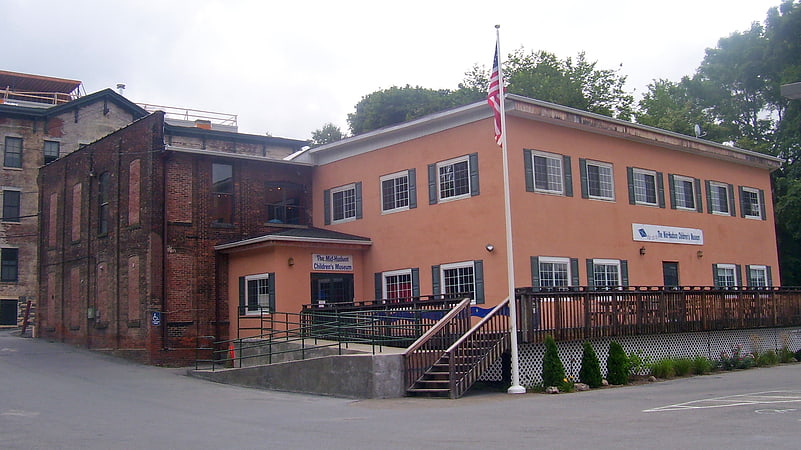
Museum in Poughkeepsie, New York. The Mid-Hudson Children's Museum is a children's museum in the Hudson River Valley between the larger New York City and Albany markets. In February 2016 MHCM opened The Science Center @ MHCM to advance early STEM education. The museum is located in the historic waterfront in Poughkeepsie.
The Mid-Hudson Children's Museum is an independent 501 not-for-profit educational organization that is supported by admission and membership sales, program fees, donations, and grants. MHCM is a member of the American Alliance of Museums, the Association of Children's Museums, the Association of Science-Technology Centers, and the Museum Association of New York.
Founded in 1989 by a group of individuals in Poughkeepsie, the Mid-Hudson Children's Museum operated in donated spaces in the City of Poughkeepsie and then in the South Hills Mall for many years. In 2002, it moved to its current home at 75 North Water Street. The building is a mid-19th century industrial brick building that formerly housed Innis Dye Works.
The board of directors of MHCM is composed of volunteers. The museum's current staff consists of fourteen employees. In fall 2012, the museum hired Lara Litchfield-Kimber as its new Executive Director.[1]
Address: 75 N Water St, 12601 Poughkeepsie (Poughkeepsie)
Mid-Hudson Civic Center
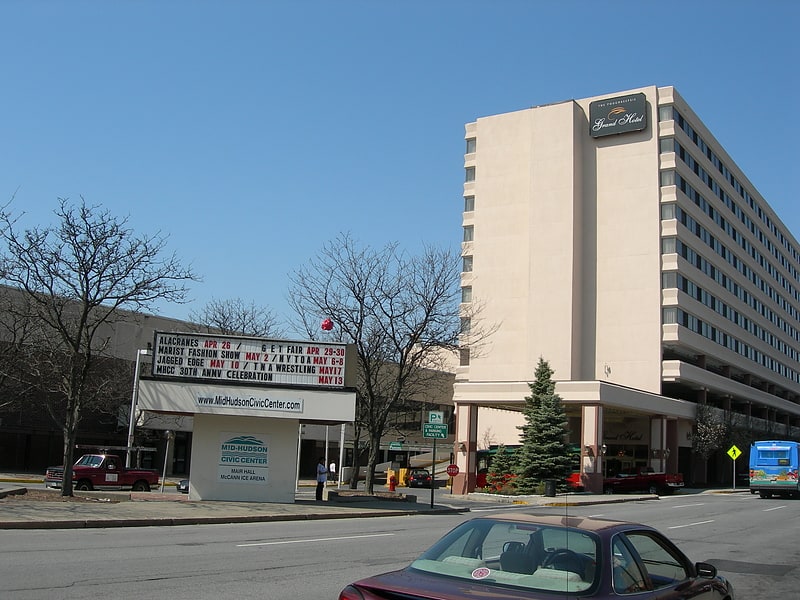
Civic center in Poughkeepsie, New York. Majed J. Nesheiwat Convention Center is a venue located in Poughkeepsie, New York, consisting of Mair Hall and the McCann Ice Arena. It was built in the 1970s as part of the general attempt at rehabilitation of the central district of the City of Poughkeepsie. It is located at 14 Civic Center Plaza, on a segment of what was formerly known as Market Street near the former Main Mall. The Poughkeepsie Grand Hotel, at 40 Civic Center Plaza, is adjacent on the same block and was originally designed to be constructed concurrently with the civic center and financed by Hilton, but the hotel construction was abandoned after the foundation was laid. Four years after the completion of the Mid-Hudson Civic Center, Radisson Hotels bought the hotel property and after a re-design of the original hotel plans, construction of the hotel resumed.
The MJN Nesheiwat Convention Center, a private, not-for-profit community organization dedicated to providing cultural, recreational and educational opportunities to the Hudson Valley is a dual venue comprising Mair Hall and McCann Ice Arena. Mair Hall is a 15,475-square-foot (1,437.7 m2) space with the capacity to host 3,050 seated spectators and large expos and trade shows.
On December 3, 2018 the Mid-Hudson Civic Center issued a press release announcing the name change of the Poughkeepsie building to the Majed J. Nesheiwat Convention Center. Majed "Mitch" Nesheiwat is a long time resident and business man of Dutchess County New York. Nesheiwat is the Founder and CEO of Gas Land Petroleum, which distributes petroleum products for companies such as Exxon Mobil, Shell, Sunoco, Gulf, Citgo, Phillips 66, and Conoco. Aside from distribution, Nesheiwat is a well-known and highly regarded real estate developer; he has diversified experience in all facets of the real estate industry. Nesheiwat made his mark in real estate through commercial development, specifically with retail plazas and residential sub-divisions.[2]
Address: Poughkeepsie, 14 Civic Center Plaza
Walkway over the Hudson

Cantilever bridge in Poughkeepsie, New York. The Walkway over the Hudson is a steel cantilever bridge spanning the Hudson River between Poughkeepsie, New York, on the east bank and Highland, New York, on the west bank. Built as a double track railroad bridge, it was completed on January 1, 1889, and formed part of the Maybrook Railroad Line of the New Haven Railroad.
It was taken out of service on May 8, 1974, after it was damaged by fire. It was listed on the National Register of Historic Places in 1979, and its entry updated in 2008. The bridge was designated as a National Historic Civil Engineering Landmark by the American Society of Civil Engineers in 2009.
It was reopened on October 3, 2009, as a pedestrian walkway as part of the new Walkway Over the Hudson State Historic Park. The New York State Bridge Authority owns and is charged with maintaining the bridge structure (as directed by the Governor and Legislature in July, 2010). The park is operated by the New York State Office of Parks, Recreation and Historic Preservation. In 2017, the walkway hosted 593,868 visitors. The park connects the Hudson Valley Rail Trail in Highland to the Dutchess Rail Trail, and forms part of the Empire State Trail.
At a length of 6,768 feet (2,063 m), it is the world's second-longest pedestrian footbridge at 1.28 miles long. It held the title as the longest footbridge from its opening until fall 2016, when it was surpassed by the 7,974-foot long (2,430 m) Mile Into the Wild Walkway at 1.51 miles in length.[3]
Mid-Hudson Bridge
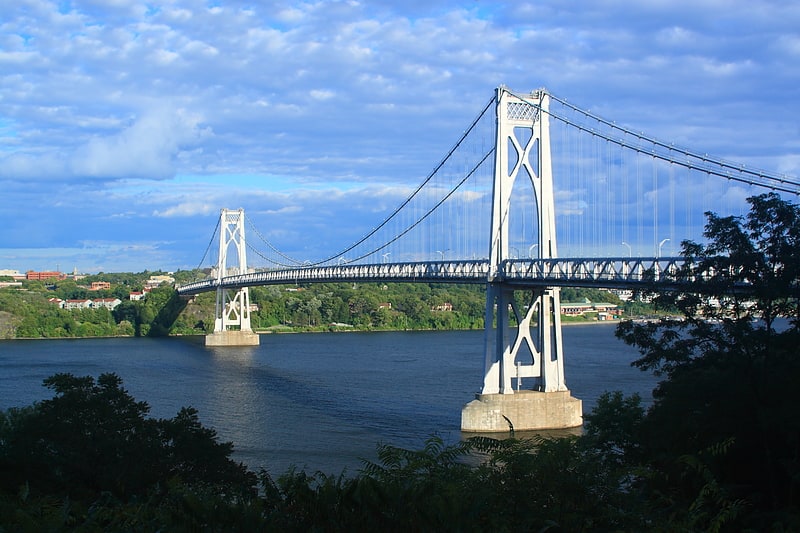
Suspension bridge in Poughkeepsie, New York. The Franklin Delano Roosevelt Mid-Hudson Bridge is a toll suspension bridge which carries US 44 and NY 55 across the Hudson River between Poughkeepsie and Highland in the state of New York.[4]
Bardavon 1869 Opera House
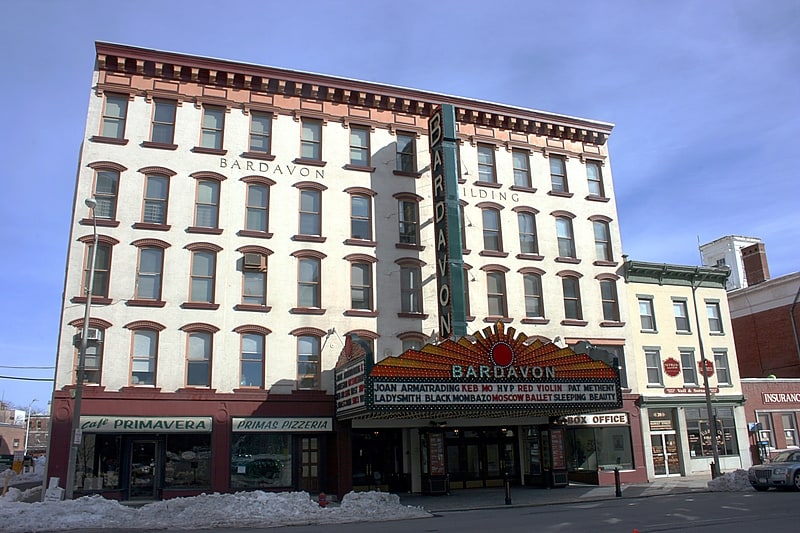
Theater. The Bardavon 1869 Opera House, in the downtown district of Poughkeepsie, New York, United States, is the oldest continuously operating theater in New York State. Designed by J.A. Wood, it was built in 1869 and served as a venue for various performing arts, community meetings, and celebrations until 1923; it largely resumed this heritage by becoming a general performing-arts facility in 1976. In the interlude period from 1923 to 1975, it served as a cinema, although there were some live performances, especially vaudeville, during this period. Originally called the Collingwood Opera House after its owner and operator James Collingwood, the theater featured an unusual two-stage dome. Between 1869 and 1921, many notable figures of the day graced the Bardavon's stage, including Sarah Bernhardt and John Barrymore.[5]
Address: 35 Market St, 12601-3214 Poughkeepsie (Poughkeepsie)
Our Lady of Mount Carmel's Church
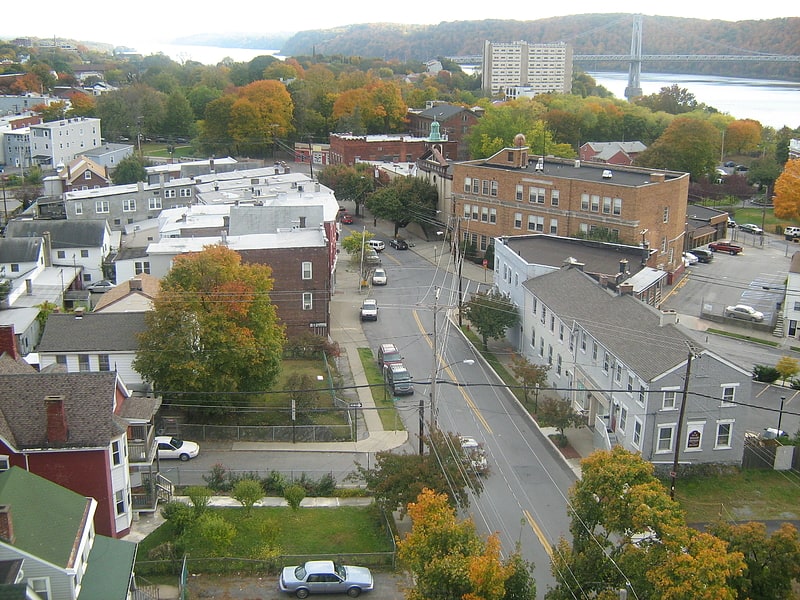
The Church of Our Lady of Mount Carmel is a historic Roman Catholic parish church building located in Poughkeepsie, Dutchess County, New York.[6]
Address: 95 Mill St, 12601 Poughkeepsie (Poughkeepsie)
Thompson Memorial Library
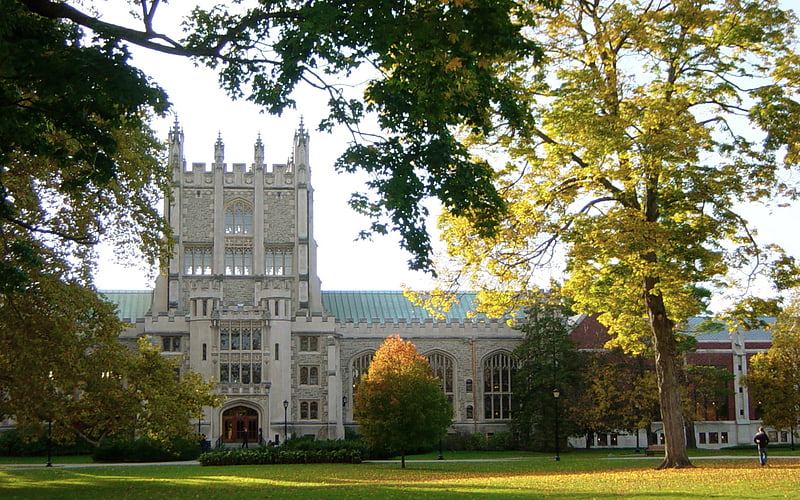
University library in the Arlington, New York. The Frederick Ferris Thompson Memorial Library is the main library building at Vassar College in Poughkeepsie, New York.[7]
Locust Grove
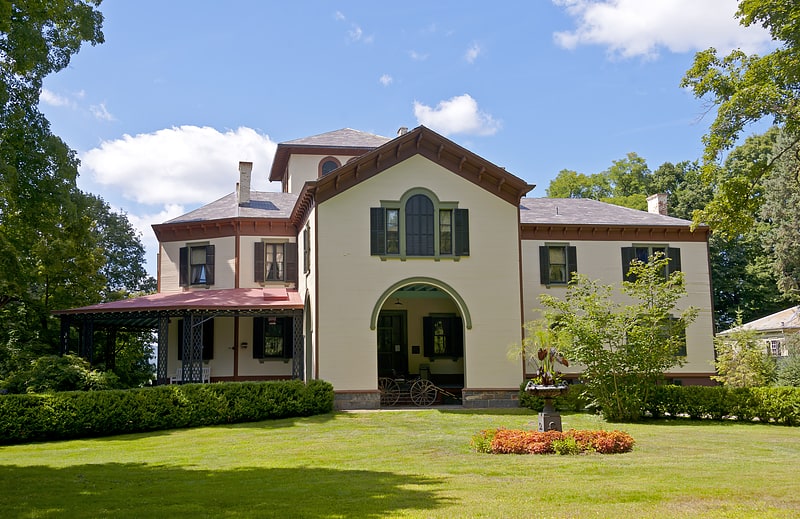
Museum in Dutchess County, New York. Locust Grove is a National Historic Landmark estate located on US 9 in the Town of Poughkeepsie, New York. The 200-acre park-like estate includes homes, a carriage house, ice house, trails, a flower garden, and vegetable garden, and it overlooks the Hudson River from a bluff. The property includes a home designed by architect Alexander Jackson Davis for Samuel F. B. Morse, the inventor of the telegraph. An Italianate style mansion, it was completed in 1851.
The estate is open to the public, tours are offered, and the site is used for weddings and parties. It includes a museum, nature preserve, antique exhibits, and a gallery showing artworks.[8]
Address: 2683 South Rd, Poughkeepsie
Vassar Chapel
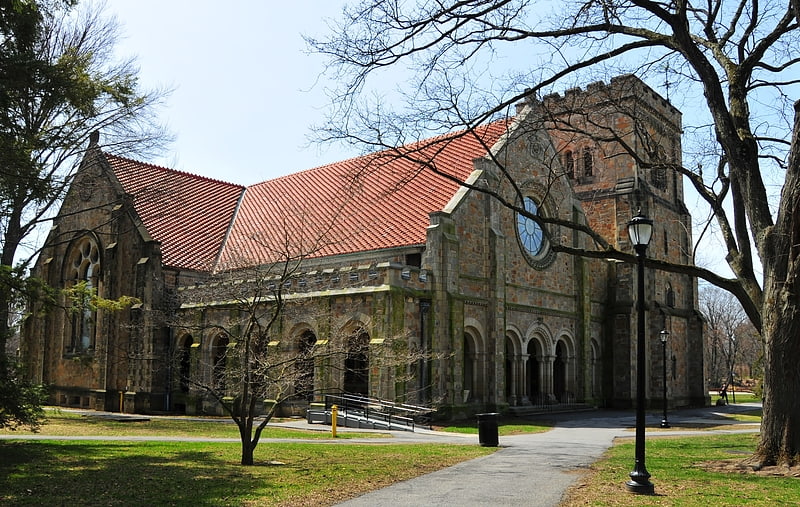
Religious building in the Arlington, New York. The Vassar Chapel, built in 1904, is the main religious building at Vassar College, and is the largest religious edifice in Poughkeepsie, New York. Although it has been altered, repaired, and acoustically improved, it is one of the few buildings at Vassar that has not undergone considerable renovation. Each semester, the College community gathers in the Chapel for fall and spring convocations, in which the President and a notable member of the faculty deliver addresses.[9]
The Chance
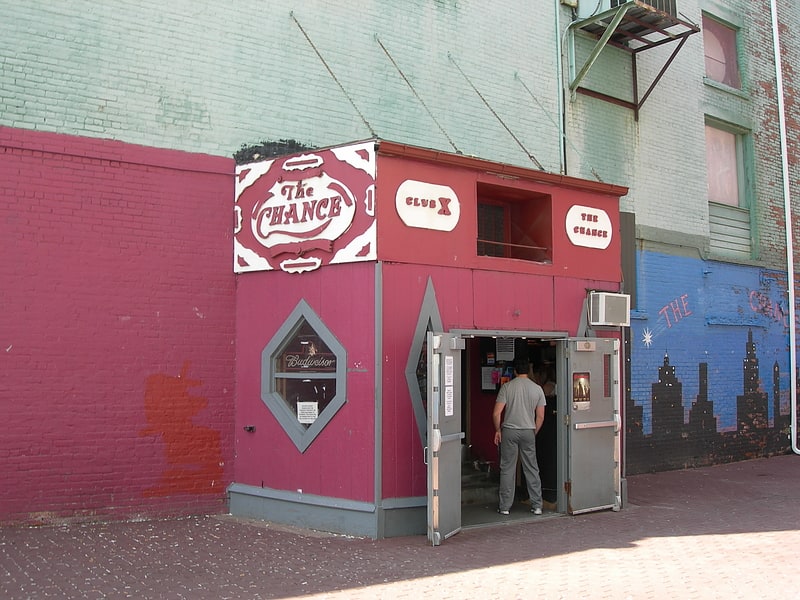
Building in Poughkeepsie, New York. The Chance is a concert and theater complex located in downtown Poughkeepsie, New York. The complex consists of four rooms: the Chance Theater, which is the primary concert hall; The Loft, a smaller upstairs concert hall; The Platinum Lounge, a downstairs bar/nightclub; and The Nuddy Irishmen, a downstairs cafe/bar.[10]
Address: Poughkeepsie, 6 Crannell St, Poughkeepsie, NY 12601-3306
Dutchess County Historical Society
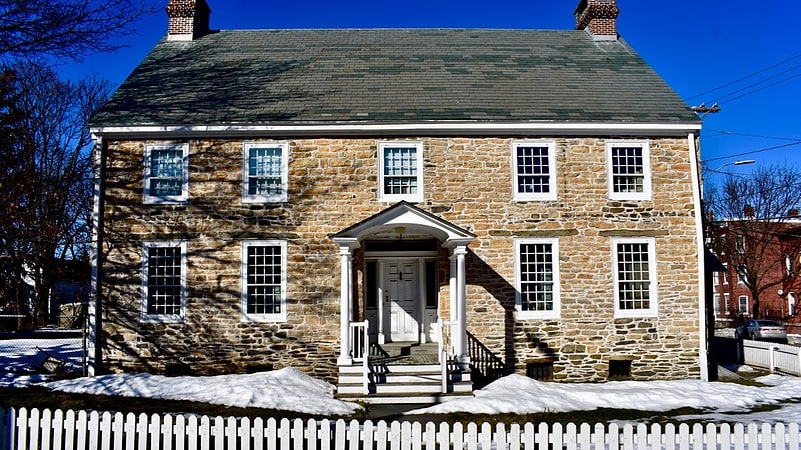
Dutchess County Historical Society, located in Poughkeepsie, New York, was formed in Pleasant Valley, New York May 26, 1914 and received its Charter from the Regents of the University of the State of New York in 1918. Its mission is to discover, preserve and share the local area's history and artifacts from the time of its earliest people to the present.
The Society's collection of documents and objects are maintained largely at Clinton House in Poughkeepsie where it has offices and a non-circulating library. It publishes an annual Yearbook, and occasionally publishes other books and pamphlets. The organization grants awards of merit and distinction each year. It conducts outreach programs that range from talks to demonstrations to workshops, and it collaborates with educational institutions and many other historic organizations and individuals in Dutchess County.
The Historical Society is funded through membership dues, the sales of its Yearbook and publications, solicitation of grants, and through philanthropic gifts and is a US tax exempt Charitable Organization.[11]
Marist College
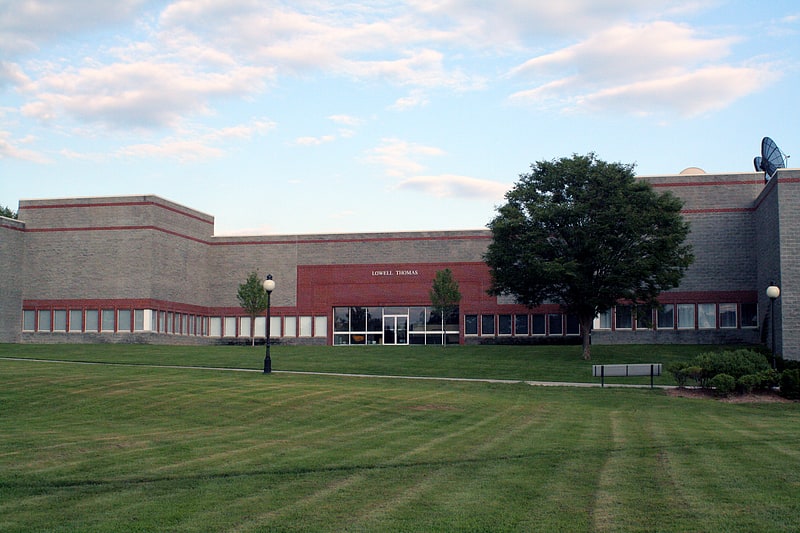
Liberal arts college in Dutchess County, New York. Marist College is a private liberal arts college in Poughkeepsie, New York. Founded in 1905, Marist was formed by the Marist Brothers, a Catholic religious institute, to prepare brothers for their vocations as educators. In 1929, Marist became accredited by the state to offer a wider range of degrees in the arts and sciences. Today, Marist offers 56 undergraduate and graduate degree programs and 21 certificate programs.
Marist's 180-acre main campus overlooks the Hudson River and is situated along its east banks. Marist has a branch campus in Florence, Italy and offers 50 semester or academic year abroad options.
A member of the NCAA's Division I, Marist sponsors 23 collegiate sports.[12]
Address: Route 9 South, 12601 Poughkeepsie
St. Mary's Church

Catholic church in Poughkeepsie, New York. The Church of St. Mary is a Roman Catholic parish church under the authority of the Roman Catholic Archdiocese of New York, located in Poughkeepsie, Dutchess County, New York City. It was established as a parish in 1873. In November 2014, the Archdiocese announced that St. Joseph's Church on Lafayette Place would merge with St. Mary's. Although remaining a church which may be used on special occasions, Masses and the sacraments will no longer be celebrated on a regular weekly basis at St. Joseph's as of August 2015.[13]
Address: 231 Church St, 12601-4200 Poughkeepsie (Poughkeepsie)
Clinton House
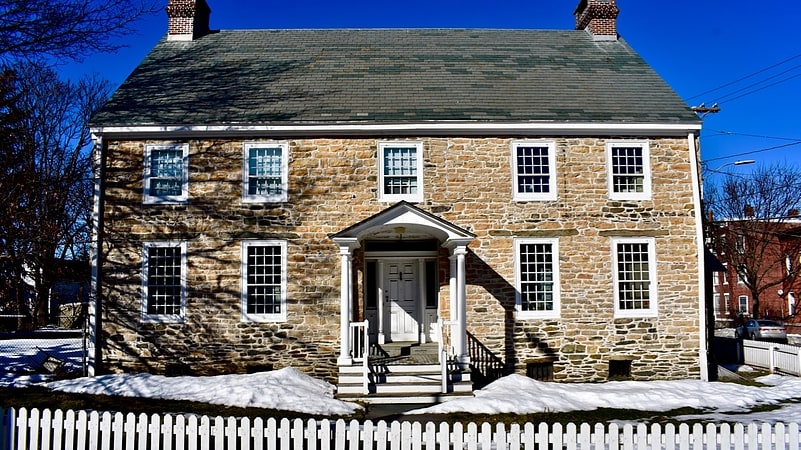
Building in Poughkeepsie, New York. The Clinton House is an 18th-century Georgian stone building in the city of Poughkeepsie, Dutchess County, New York, United States. It is a New York State Historic Site and has been listed in the National Register of Historic Places as a historic place of local significance since 1982. The house was named for George Clinton, who served as the first Governor of New York and fourth Vice-President of the United States. He was believed to have lived there after the American Revolutionary War, but it is now known that it was never his residence.
The house probably served as a meeting place for legislators during the time Poughkeepsie was capital of New York in 1777.
Clinton House was built around 1765 by Clear Everitt, who was sheriff of the county from 1754 to 1761, on land that had belonged to Hugh van Kleeck (born about 1745, died after 1810) who owned about 20 hectares of land south of Main Street where the house stands. (The Van Kleeck House built in 1702 was demolished in 1836.) In 1780, the house was purchased by Udney Hay, who belonged to Quartermaster Corp of the Continental Army. In 1783, the house was destroyed by fire and Hay rented the nearby Glebe House. When his house was damaged by fire, Hay petitioned George Washington for craftsmen from the army to assist in its repair. However, Hay lost the house in 1786 when it was seized for debt.
In 1900, the house had fallen into disrepair and it was purchased by the Daughters of the American Revolution, who presented it to the then Governor of New York Theodore Roosevelt for the citizens of the State of New York.
It was listed on the National Register of Historic Places in 1982.
Today, the Clinton house is used for the offices and library of the Dutchess County Historical Society, with one room still set aside for use by the Mahwenawasigh Chapter of the Daughters of the American Revolution.[14]
Address: 547 Main St, Poughkeepsie (Poughkeepsie)
Adriance Memorial Library
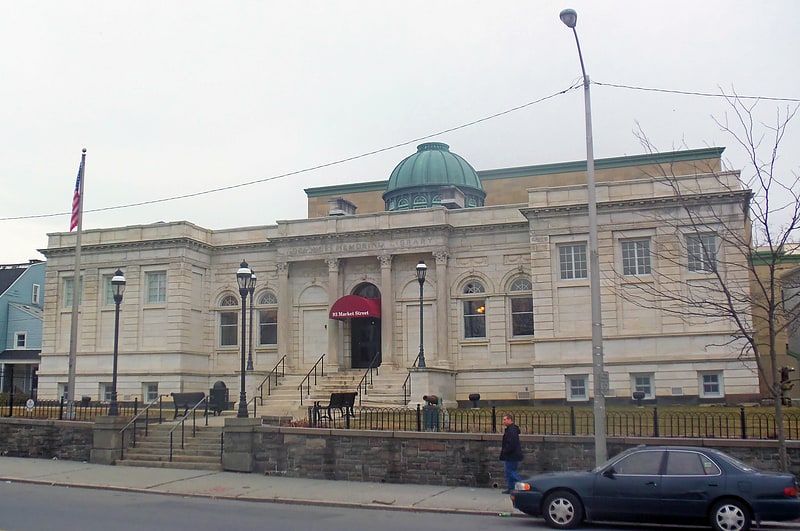
Building in Poughkeepsie, New York. The Adriance Memorial Library is located on Market Street in Poughkeepsie, New York, United States. It is a stone building in the Classical Revival architectural style erected shortly at the end of the 19th century. In 1982 it was listed on the National Register of Historic Places.
It is the oldest tax-supported library in the state and the third oldest in the United States, dating back to 1839 at various locations prior to the construction of the current building. It is also the main public library of the Poughkeepsie Public Library District, serving the city and town of that name, with a branch in the suburb of Arlington. It is a member library of the Mid-Hudson Library System, which has its headquarters next door.
The building has been through two renovations and expansions. A large rear wing was built in the 1920s. It was removed in the early 21st century to make way for an even larger addition. During that time the main building was closed as well for renovations. It was reopened in 2009 with its appearance and layout intact.[15]
Address: 93 Market St, 12601-4099 Poughkeepsie (Poughkeepsie)
Second Baptist Church
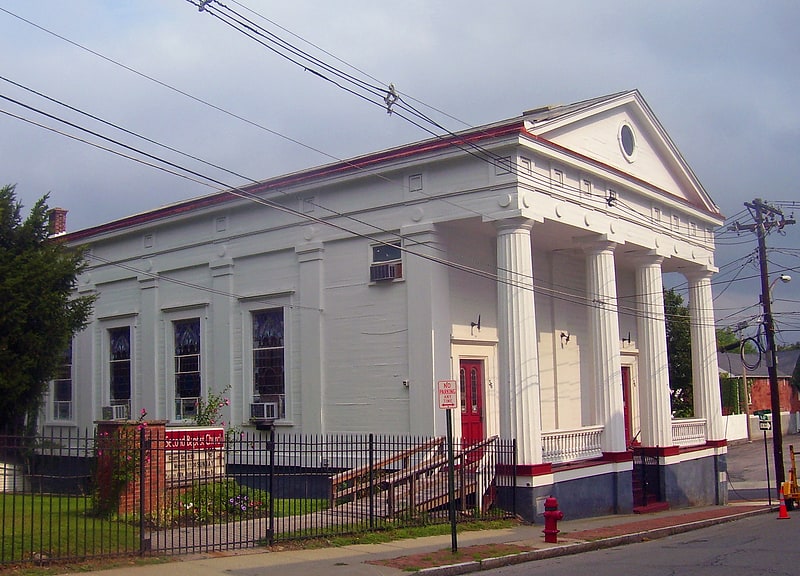
Baptist church in Poughkeepsie, New York. The Second Baptist Church in Poughkeepsie, New York, United States, is located at the corner of Vassar and Mill streets. It is a wooden building from the late 1830s in the Greek Revival architectural style, the only remaining church in the city in that style.
A number of congregations have used the building since it was first erected. It was even a synagogue at one point, possibly leading to the nickname Vassar Temple, since it was built on land originally owned by Matthew Vassar, founder of Vassar College. In 1972 it was listed on the National Register of Historic Places, and later became a contributing property to the Mill Street-North Clover Street Historic District.[16]
Address: 36 Vassar St, 12601-3021 Poughkeepsie (Poughkeepsie)
Zion Memorial Chapel
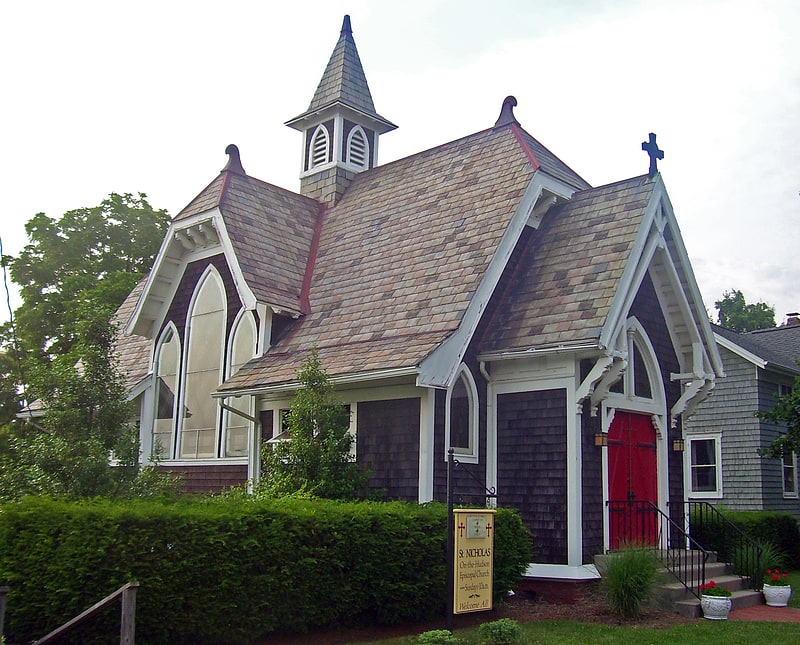
Church building in New Hamburg, New York. Zion Memorial Chapel, now known as St. Nicholas-on-the-Hudson, is an historic Carpenter Gothic style Episcopal church building located at 37 Point Street in New Hamburg, New York, United States. It was built in 1902 as a chapel of nearby Zion Church in Wappingers Falls and became a separate parish in 1983.
The small wooden church building overlooks the nearby Hudson River. It was built in the early 20th century in a late interpretation of the Gothic Revival architectural style. For that reason it was listed on the National Register of Historic Places in 1987.[17]
Address: 37 Point St, Poughkeepsie
St. Paul's Episcopal Church
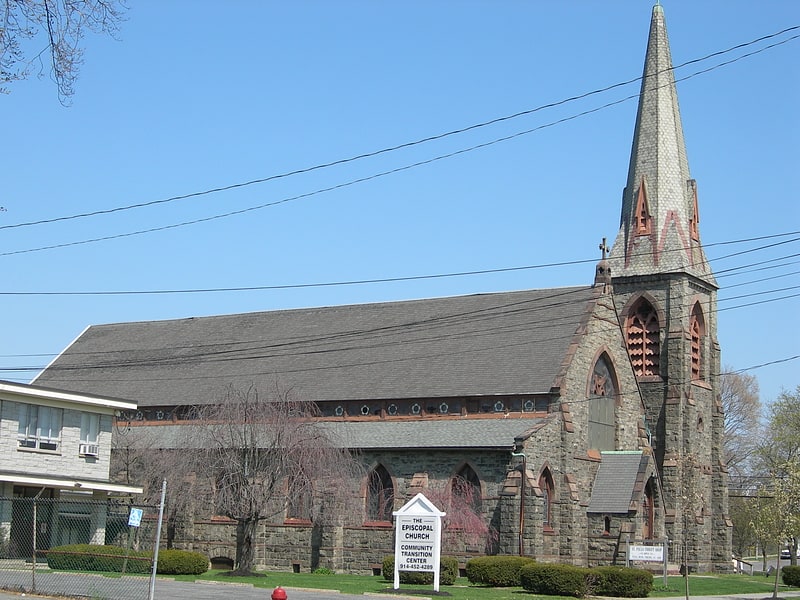
Church in Poughkeepsie, New York. St. Paul's Episcopal Church is located at North Hamilton and Mansion streets on the west side of Mansion Square in Poughkeepsie, New York, United States. It is a stone church in the Norman-Gothic Revival styles built in the late 19th century.
Designed by New York City architect Emlen Littell, it has had additions and renovations by other well-known architects, such as Frederick Clarke Withers and Richard Upjohn. The interior treatment was done by Tiffany & Co. in the early 20th century. In 1982 it was added to the National Register of Historic Places.[18]
Address: 161 Mansion St, 12601-2524 Poughkeepsie (Poughkeepsie)
Poughkeepsie City Hall
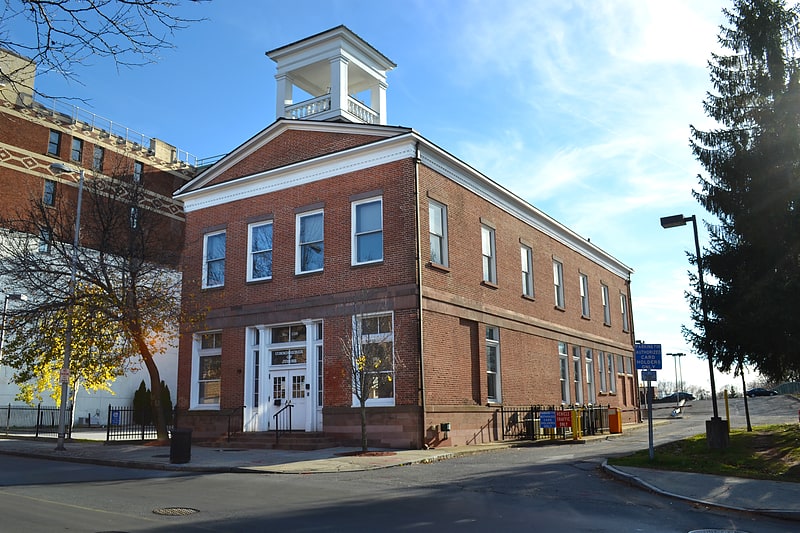
Building in Poughkeepsie, New York. Poughkeepsie City Hall is a historic city hall located in Poughkeepsie, Dutchess County, New York at 228 Main Street. It was built in 1831 and is a two-story, red brick building with a basement and attic, in the Greek Revival style. It has a gable roof with a rooftop belfry with square columns, spindle balustrade, and slate covered hipped roof. It is currently used as the Commissioner of Jurors Office.
It was added to the National Register of Historic Places in 1972.
Poughkeepsie's current city hall stands around the corner at Civic Center Plaza and is constructed in the brutalist style.[19]
First Baptist Church

Baptist church in Poughkeepsie, New York. The First Baptist Church is an historic American Baptist church located at 164 South Cherry Street in Poughkeepsie, Dutchess County, New York. It was built between 1875 and 1877, and consists of a rectangular main church section, front entry pavilion, and tall rectangular bell tower. The brick building features Gothic arched openings and stone tracery.
It was added to the National Register of Historic Places in 2001.
The architectural design of the Baptist Church erected on the former site of the Temperance Hall on Mill Street was placed in the hands of the committee by Mr. James Strang Post, Architect, in July 1874. The edifice built has a frontage of seventy feet and a depth of one hundred and sixty feet; tower one hundred and eighty feet in height. The materials used are pressed brick, with Ohio and blue stone trimmings. The seating capacity was estimated to be about one thousand. The whole cost in 1874 was to be in the neighborhood of $55,000. The work commenced 1 August 1874.
The Corner Stone ceremony was reported in the Poughkeepsie Eagle News 11 Aug 1875, page 3. Many documents and articles of the time were deposited in the Corner Stone and listed in the newspaper article. The Corner Stone is made of brown stone and cut in relief on its outside was the year 1875. Inside the Corner Stone included the name of the architect James Strang Post, the many church officials, those present at the ceremony as well as a Honor Roll of those persons donating $1 or more to the building project fund. The church was organized in 1800. Its first church building was built in 1808 and removed in 1874 to prepare for the new structure in 1875. A larger house of worship was utilized in 1839 in Lafayette Place. The building of the 1875 structure allowed the two smaller houses of worship a facility large enough for all to attend.[20]
Reformed Dutch Church of Poughkeepsie
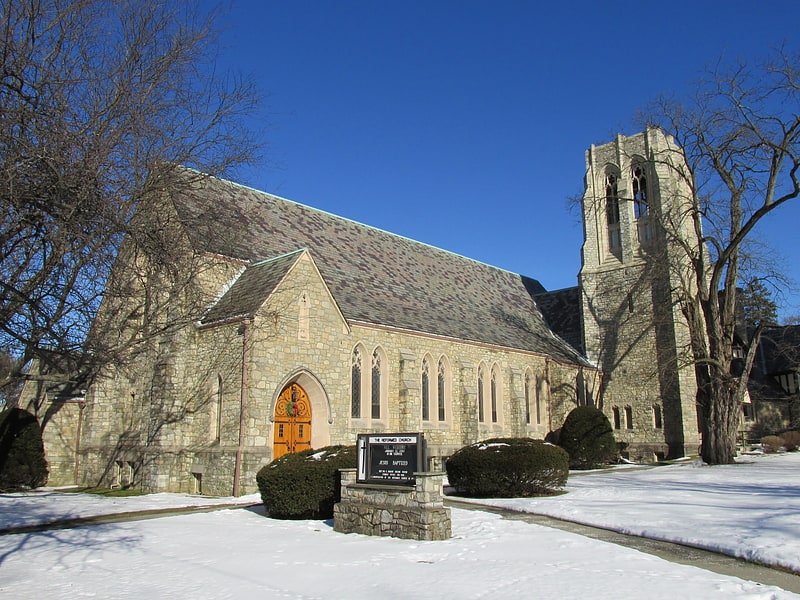
Building. Reformed Dutch Church of Poughkeepsie is a historic church at 70 Hooker Avenue in Poughkeepsie, New York.
The original congregation was formed in 1716. The building was constructed in 1921 and added to the National Register of Historic Places in 2008.
It was designed by Charles Collens.[21]
First Presbyterian Church
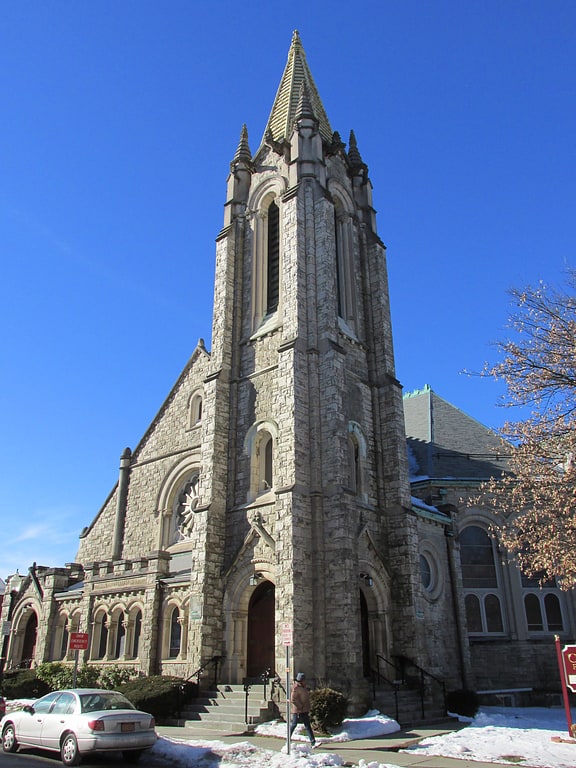
First Presbyterian Church is a historic Presbyterian church located at Poughkeepsie, Dutchess County, New York. It was built in 1905 and is a large, five sided stone building with a wing. It features a three-story square tower with a pyramidal roof and arched Romanesque window surrounds.
It was added to the National Register of Historic Places in 1982. The related rectory was added at the same time.[22]
First Presbyterian Church Rectory

Rectory in Poughkeepsie, New York. First Presbyterian Church Rectory is a historic Presbyterian church rectory located at Poughkeepsie, Dutchess County, New York. It was built about 1857 and is a 2+1⁄2-story brick dwelling on a raised basement in the Second Empire style. It is five bays wide and features a bellcast mansard roof.
It was added to the National Register of Historic Places in 1982. The related church was added at the same time.[23]
United States Post Office
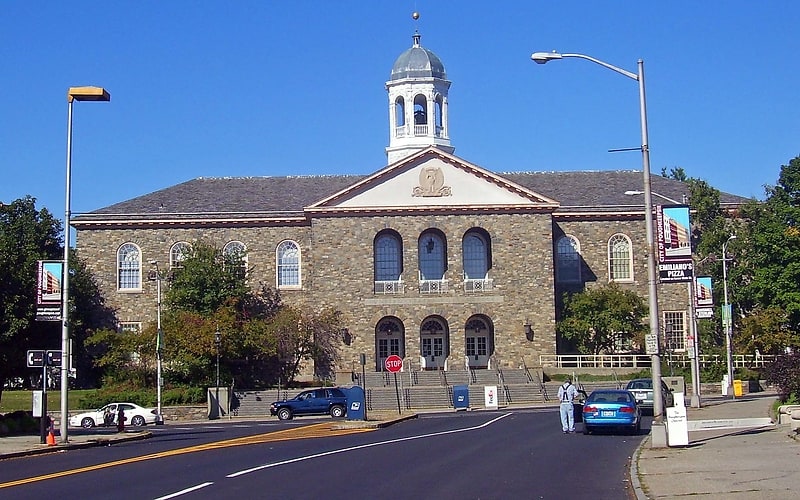
Post office in Poughkeepsie, New York. The main U.S. Post Office, Poughkeepsie, New York, USA, is located at the intersection of Market and Mansion Streets downtown. The Post Office serves the 12601 ZIP Code, which covers the city of Poughkeepsie, New York and portions of the Town of Poughkeepsie adjacent to the city. It employs a hundred people and handles 300,000 pieces of mail a day and 10 million a year.[24]
Address: 55 Mansion St, Poughkeepsie (Poughkeepsie)
Dutchess County Court House
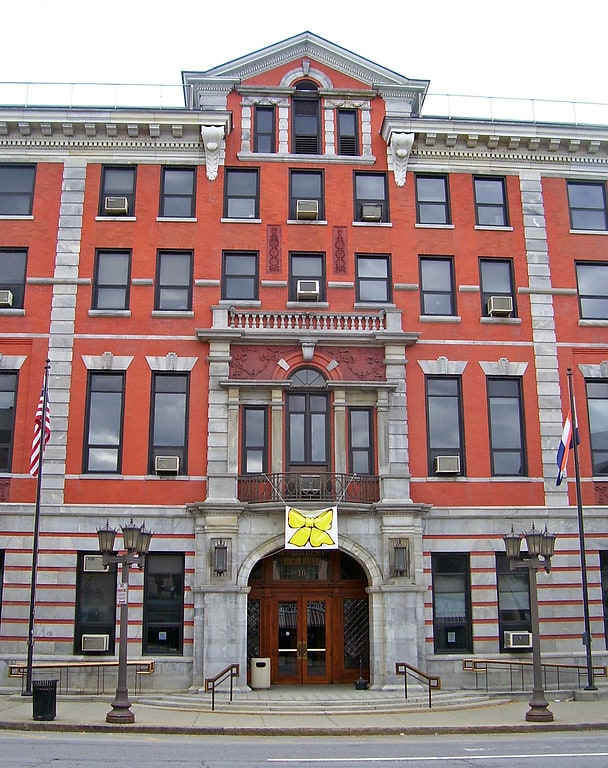
Courthouse. The Dutchess County Courthouse is located at 10 Market Street in downtown Poughkeepsie, New York, United States. Built in 1903, it is the third county courthouse to stand on that site.
The first was authorized by the provincial assembly in 1717 and built in 1720, and would host New York's debate on ratifying the U.S. Constitution during the brief period when Poughkeepsie served as the state capital in 1788. It was destroyed in an 1806 fire. Three years later the state legislature appropriated funds for a new one, which stood for almost a century. An early tenant beside the courts was brewer Matthew Vassar, later founder of Vassar College, who ran an alehouse and oyster bar in the basement.
It was replaced by the current building, a four-story Classical Revival designed by local architect William J. Beardsley. Faced with red brick, the half-million dollar structure featured Palladian windows in the second and fifth-story center bays with stucco decoration above. It opened and was dedicated just before the end of 1903.
Later alterations were made under the direction of Charles Cooke, who designed the nearby offices of the Poughkeepsie Journal. The building's cornice is the only element that has been significantly changed from the original design. It has also been joined to the Poughkeepsie Trust Company building to its immediate east on Main Street, which serves as the district attorney's offices.
In 1982, it was added to the National Register of Historic Places. Today, it houses judges' chambers and clerks' offices as well as courtrooms. Most of the court's lesser functions, such as property recordkeeping, have been moved to an annex next door, built in the 1960s. In the late 1990s, it was the venue for former Dutchess assistant district attorney Stephen Pagones's defamation suit against Al Sharpton, C. Vernon Mason and Alton Maddox over allegations they made against him during the Tawana Brawley affair.[25]
Address: 10 Market Street, Poughkeepsie (Poughkeepsie)
Poughkeepsie Rural Cemetery
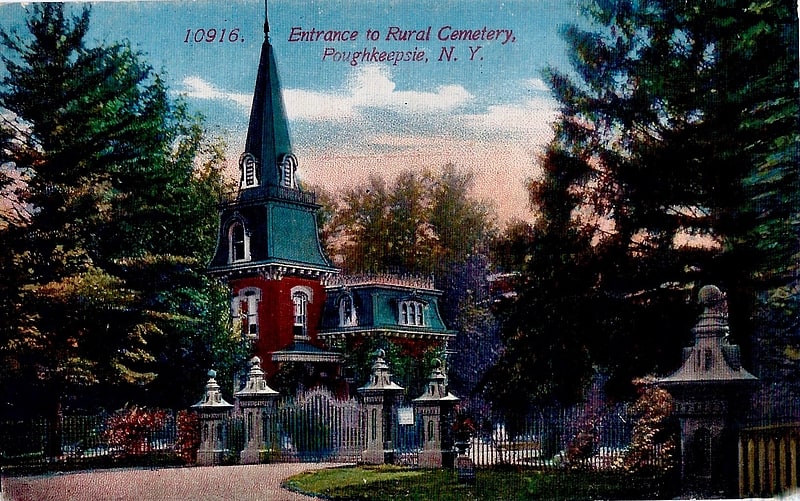
Cemetery in Dutchess County, New York. The Poughkeepsie Rural Cemetery is a rural cemetery located in Poughkeepsie, New York and includes the gravesites of several notable figures. It also has a crematory. The forty-four acres of land used for the cemetery were purchased by Matthew Vassar.
Some of its architectural features were designed by J. A. Wood. His work includes the cemetery gates and gatehouse, the Frost Mausoleum, and a monument for Matthew Vassar's nephew, John Guy Vassar.[26]
Morgan Lake
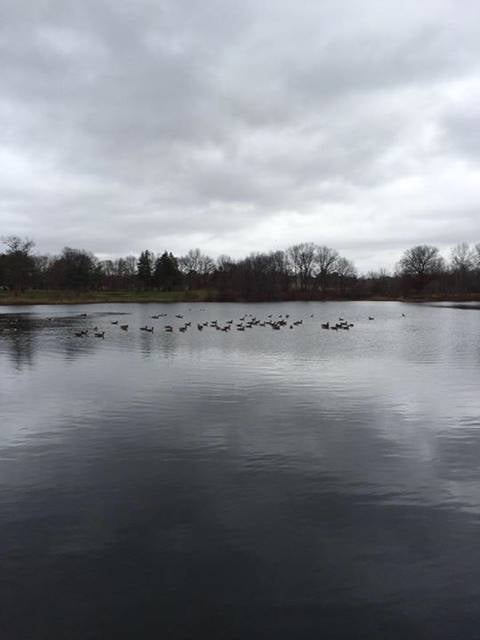
Park, Relax in park
Address: Creek Rd, Poughkeepsie (Poughkeepsie)
Barrett House
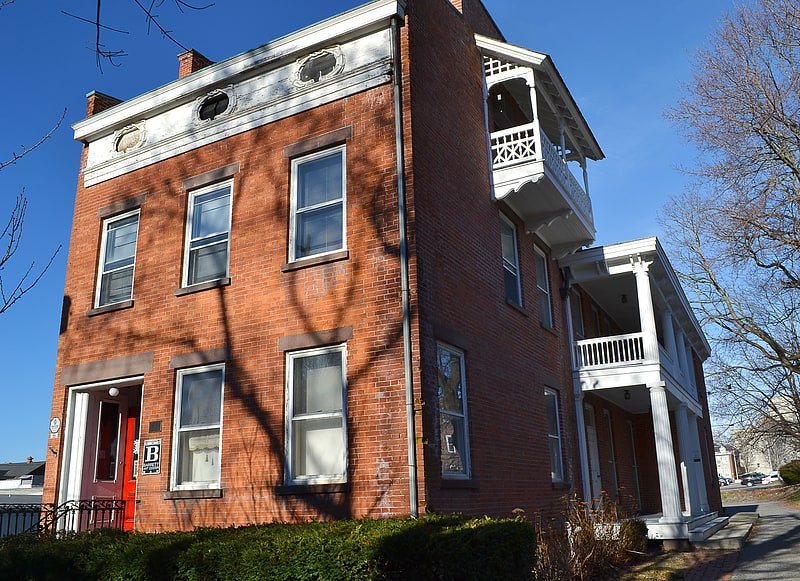
Historical landmark in Poughkeepsie, New York. Barrett House is a historic home located at Poughkeepsie, Dutchess County, New York, today home to Barrett Art Center. This triple-landmark Greek Revival brick townhouse was built in the early 1840s. The Barrett House reflects three phases of construction. The original building is a ca. 1842 three-story, three-bay by four-bay Greek Revival brick house with a side-gabled, stepped roof. A two-story, three-bay by two-bay, front-gabled brick addition was constructed to its rear ca. 1867.
In the twentieth century, Barrett House achieved notoriety as the family home of Poughkeepsie-born WPA muralist Thomas Weeks Barrett. Jr. (1902-1947), who founded the Dutchess County Art Association (DCAA) in 1935 and lived there until his death in 1947. His artwork, family archive, and DCAA records remain in the house today.
Thomas W. Barrett, Jr. graduated from the School of the Museum of Fine Arts, Boston in 1926, but his energies and artwork centered on the Hudson Valley. Barrett worked professionally as a designer, painter, printmaker, and as a muralist for the Treasury Relief Art Project (1936) and the Works Progress Administration (1937). As a Hudson Valley “American Scene” painter Barrett fashioned a modern iteration of the region's landscapes first immortalized a century earlier by the founders of the nation's first major art movement, the Hudson River School. Barrett turned his artistic attention to the urban landscapes of cities along the Hudson as symbols of a resilient and modern American character. Barrett organized the first art exhibition in Dutchess County at the Luckey Platt Department Store in 1934. Barrett founded the DCAA a year later.
Barrett died in 1947 and his sister bequeathed the townhouse to the DCAA in 1974. The DCAA subsequently converted its first and second floor living spaces to four galleries, a community arts space, and offices, and operates under the name Barrett Art Center. Today, the third-floor studio Barrett designed in 1930, with a 7-foot by 9-foot north-facing sky-light, is an active studio used by an artist in residence. The DCAA collection includes artwork – much of it Barrett's – and archives including his family papers, film, photographs, manuscripts, memorabilia, and DCAA records, all of which remain in the house.
The three-story, three bay brick building in the Greek Revival style. It is on a raised basement and features brownstone trim and a third story Eastlake style porch.
It was added to the National Register of Historic Places in 1982.
Early 19th century Poughkeepsie & the Construction of 55 Noxon Street
One of the oldest communities along the Hudson River, was initially settled during the late seventeenth century. Though it grew slowly, it was well situated near the major transportation routes and was named the county seat in 1717. The village became a center of commerce and trade and by the nineteenth century its economy came to be dominated by industry and manufacturing. For about a decade starting in 1832, Poughkeepsie also became an important center of the regional whaling industry. During the late 1830s and early 1840s, Poughkeepsie experienced a real estate boom in response to the growth of these enterprises and the efforts of the local Improvement Party, a group of businessmen and politicians who boosted the City within the region. The area's role as a manufacturing center was spurred by the completion of the Hudson River railroad to Poughkeepsie in 1849.
Virgil D. Bonesteel, an ambitious Yale graduate (Phi Beta Kappa, Class of 1827) and descendant of Red Hook's early settlers, was one of the new professionals attracted to the bright future of Poughkeepsie that was heavily promoted during the boom years of the 1830s. His first position was that of law student in the office of James Hooker, Dutchess County's Surrogate for 16 years and a dominant force in the awarding of political patronage jobs within the Democratic Party. Bonesteel quickly became an up-and-coming young leader in county and state Democratic Committee work and was appointed Clerk of the County Board of Supervisors. His rise in these political and legal circles may have been assisted by his marriage in 1840 to Sarah E. Todd of New Milford Connecticut, the niece of Poughkeepsie attorney and former Secretary of the Navy, Smith Thompson who was then serving as a Justice on the United States Supreme Court.
Following the national financial panic of 1837, Poughkeepsie's booming real estate market ground to a near-halt. Bonesteel was able to take advantage of this, purchasing a lot for $1,325 on Noxon Street at a foreclosure auction in November 1841. The lot was made available by the financial collapse of shoe manufacturer Benjamin Bissell, one of the many who had ventured into real estate speculation during the ‘years of Poughkeepsie’s “Improvement Party” boom in the mid-1830s.
Newly married, Virgil and Sarah Bonesteel began constructing their home soon after; construction most likely occurred in 1842 since Bonesteel is listed as residing at 55 Noxon St. in the first extant village directory of 1843. The builder is unknown. The completion of the elegant brick town home projected Bonesteel's success within the community. Well-to-do families of this period, such as the Bonesteels, expressed their taste within this restrained form of domestic architecture that symbolized a young nation's hopes for becoming the new embodiment of the purity, strength and equality of an idealized ancient Greece. With its wide frieze of wreathed attic windows, ornamental stoop railing, two story porch with fluted Doric columns, and recessed double front door with rectangular transom, the Bonesteels’ Greek Revival townhouse embodied the quiet elegance typical of this style.
In 1844, Bonesteel was appointed to the position of Dutchess County Surrogate. But the rough and tumble of politics derailed Bonesteel's rise when his enemies in the opposing Whig party accused him of levying “bloodsucking” fees on defenseless widows and orphans forced to settle their estates in his court. Bonesteel's seemingly extravagant personal life also came under fire by his enemies in the Whig party newspaper who sarcastically observed, “We understand that our surrogate made an excursion the other day to New Milford WITH A COACH AND FOUR. Now it is clearly none of our business how he rides, but as he is now the leader of the party in the county, he must excuse us for feeling concerned about THE DEMOCRACY OF THE THING…”
Whether it was a “coach and four” lifestyle, excessive real estate speculation or some other unknown factor, Bonesteel declared bankruptcy in 1848. In 1849, his extensive real estate holdings were sold to pay his debts. The Bonesteel home at 55 Noxon Street was described in foreclosure auction advertisements as a “large and spacious house, one of the most desirable in Poughkeepsie.”
19th Century History of 55 Noxon Street
From 1849 to 1866, 55 Noxon St. was owned by Eliza Thompson, the widow of Supreme Court Judge Smith Thompson. Eliza Thompson was the daughter of Henry Livingston, Jr. and grew up on the Livingston estate we know today as Locust Grove. In 1836, she married the much older widower, Supreme Court Justice Smith Thompson and became the elegant young hostess of an elite political circle at her husband's riverfront estate “Rust Plaetz” (now part of Poughkeepsie Rural Cemetery). Eliza Thompson used 55 Noxon as an income-producing property, renting it to a series of well-to-do tenants.
During the years she owned 55 Noxon Street, Eliza Thompson remarried and began a new life elsewhere. The rental of 55 Noxon Street may have been managed for her, possibly by Jennette Jewett who purchased the property in 1866 and two lots on Mill Street for $14,425. Jewett owned other properties in the city and was not new to the real estate world. In fact, she was the daughter of one of Poughkeepsie's first Main Street developers, the industrialist and inventor Gilbert Brewster. Jennette Jewett likely saw a good investment opportunity in 55 Noxon Street. Properties like it, which were being used as “high class boarding houses,” were in high demand in 1866. A year later, Jewett sold 55 Noxon for $7,000. By 1869, she had sold the property on Mill St. for $8,500 - netting a profit of $1,075 on the deal. The doubling of the house's value from $3,550 in 1849 to $7,000 in 1867 suggests that the large rear addition to the house was completed sometime between 1849 and 1867.
In 1867, Jewett sold the property to retired Marlborough farmer Benjamin F. Townsend and his wife Lucy. Census records show that they operated 55 Noxon as a boarding house; assorted white-collar boarders occupied rooms in the house during the Townsend years at 55 Noxon Street. The number of boarders grew to as high as 14 by 1875 when Lucy Townsend (by then a widow) was described as “keeping a boarding house” in the federal census. At Lucy Townsend's death in 1879, the house was inherited by her wealthy nephew George W. Townsend. The house was sold by his heirs in 1882 to Captain James H. Wheeler and his wife Phebe. Wheeler's earliest years were said to have been spent at sea followed by work as a ship builder, hotel keeper and operator of a small boat on the Hudson. The nickname “Captain” followed him his entire life. During his years at 55 Noxon Street, from 1882 to 1887, Wheeler used the house as his family home and for his business as an awning and sail maker.
After failing to sell the house at auction in 1887, the Wheelers sold it two years later to Miss Mary Elizabeth Weeks for $4,500. Within the decade after her purchase, the family likely added the rearmost addition to the house to update and expand its kitchen space. For the next three generations, the house would stay in the Weeks-Barrett family. The sister of prominent lawyer James H. Weeks, Mary purchased the house at a time when the family was in transition soon after her brother's death. Without the patriarch James Weeks, described in an 1881 newspaper article on real estate assessments as “the richest man in town,” the family began sinking into shabby gentility. The family's first decade in their new home at 55 Noxon was filled with loss. In 1892, Mary Elizabeth died of pneumonia. In 1893, Charles W. Barrett, the husband of James Weeks’ sister Eloise, also died. Perhaps most tragic was the loss of Eloise and Charles Barrett's son, the quiet and reserved young bank clerk Charles K. Barrett, who died of tuberculosis at age 27 in 1894. Finally, another of Weeks’ sisters, Emily Weeks Vary died in 1897. It must have seemed that the spell of sadness was at last broken in 1900 when Eloise and Charles Barrett's other son, Tom Barrett, married Miss Kate Stoutenburgh of Washington D.C. and Hyde Park. Unfortunately, a year later, Tom Barrett and his wife Kate were burying their infant son.
However, Kate's arrival did start a new, more prosperous chapter in the family's history. Tom Barrett began a promising career at the Poughkeepsie National Bank, following in the footsteps of his deceased brother Charles and his uncle Isaac. At 55 Noxon Street, Tom and Kate Barrett settled into the quiet life of a small-town banker and his wife raising their two children, Thomas Jr. and Elizabeth, in a sheltered and loving environment with idyllic summers spent at the Putnam, Connecticut farm of Kate Barrett's father.
Thomas Weeks Barrett, Jr. (1902-1947)
Born in 1902, Tom Barrett enjoyed a sheltered and loving childhood at 55 Noxon Street. As an adult, Barrett gratefully noted that he had been born into a “protected sphere of family care which has not diminished.” The remarkably tender devotion and domesticity of the Barrett family is evident in the diaries, photos, letters and clippings the family lovingly saved as cherished objects which are now preserved in the Barrett Art Center's archive at 55 Noxon Street. In their public lives, the Barretts showed equally impressive loyalty to their community. Barrett's father, a banker for 54 years, was the trusted expert the community turned to when it needed a treasurer for major civic projects like saving the historic Glebe House from demolition, building St. Francis Hospital, or creating the Bowne Memorial Tuberculosis Sanitarium. Barrett's mother was engaged with the community as well, although in the traditionally acceptable ladylike activities of the D.A.R. and the women's auxiliary of Christ Church.
Barrett began his career in the mid-1920s as a freelance commercial artist for New York City department stores and manufacturers - designing things like playing cards, book plates, wallpaper, and radio cabinets. Unable to make a living at this as the Depression deepened, Barrett returned home to 55 Noxon Street in 1929 where he lived for the rest of his life, working from the attic studio he created, which looked out over the backyards and rooftops of his “dear Poky.”
During the summers of 1928–1930, a fundamental shift began occurring in Barrett's life as an artist. While visiting friends in New Hampshire, Maine and Massachusetts, Barrett began experimenting with oil painting. His depictions of the mills, fishing sheds and wharves of New England caught the attention of art critics and launched Barrett in a new direction. His new success with oil painting brought exhibit opportunities in New York at the Anderson Gallery, Argent Gallery, Times Gallery, Fifteen Gallery, Academy of Allied Arts, and the Brooklyn Museum. Outside of New York City, Barrett's work appeared at the Pennsylvania Academy of Fine Arts, the Philadelphia Print Club, the Albany Institute of History and Art, the Connecticut Academy of Fine Arts, the Palm Beach Art Club, the Wood Cut Society of Kansas City and the Wichita Art Association. In the Hudson Valley, Barrett held one man shows at Bard College and the Hudson River Museum in Yonkers. Like other Depression era artists, Barrett also found work as a WPA muralist in 1936 and 1937 and became deeply committed to the art of social realism and the goal of introducing art into everyday life through murals and free public exhibitions.
Throughout the 1930s, Barrett continued to more fully explore localism, an art movement that focused on looking for the universal in the particular. He obsessively painted Poughkeepsie, his own home town, in all its desolate and gritty beauty. In 1941, Barrett achieved one of his proudest moments when art critic and collector Duncan Phillips purchased his painting “Downtown Poughkeepsie” for the Phillips Memorial Gallery in Washington D.C.
Tom Barrett Jr.’s focus extended from painting Poughkeepsie to growing its arts community and improving the local quality of life. He pursued a particularly bold agenda for community betterment, advocating for a municipal art gallery, a civic center, and a reimagined waterfront long before others in his community realized the importance of these key elements in urban design. From 55 Noxon Street, Tom Barrett also organized the county’s first art show in 1934. The show, which was held on the top floor of the Luckey-Platt Department store, included the work of approximately 50 local artists. A few months before his death in 1984, fellow artist Vince Walker remembered how it all began:
A group of us used to meet in Barrett’s studio to do some sketching and drawing. Tom and I thought it would be a good idea to get an exhibition together so we drove around the county and talked to some artists. Tom contacted Eleanor Roosevelt and some others to sponsor the exhibit. There really was no art community in Poughkeepsie at the time. Exclusive of exhibits at Vassar College, this was the first art exhibition in the community.
Over 2,000 people visited this first ever regional art exhibit in the auditorium on the top floor of the Luckey-Platt Department Store. The press pronounced it “exhilarating” and an “eye opener of startling dimensions.” The community seemed stunned not just by the talent they saw revealed but also by how oblivious they had been to its existence. The following year, Tom Barrett and Vince Walker formalized this initial success by founding the Dutchess County Art Association. Tom Barrett served as its first president.
Never content with leaving art inside a gallery, Barrett also became county chairman of the national program “American Art Week” which promoted the placement of art in the windows of stores, banks, theaters, and hotels in cities and towns across the country during the first week of each November. Barrett's sister Elizabeth, known to her family as Bet, supported her brother's efforts to grow and sustain the local arts community. A long-time employee of the Poughkeepsie Bank and Trust Company, she helped the arts community with her financial skills. For example, she served as treasurer of the “Victory Calendar” project of 1943. This fundraiser for local war work agencies captured the attention of President Roosevelt, who invited the Victory Calendar artists to hold an exhibit of their work at the FDR Library with a special opening ceremony hosted by the first lady.
Barrett's most cherished dream, however, remained the creation of a dedicated space for art exhibits and classes. During much of Barrett's life time, artists of the region had to rely on leased or donated exhibit space in various venues such as the Luckey-Platt Department Store, the Hotel Campbell, Three Arts Bookstore, the Elverhoj Art Shop, the IBM Country Club, and the county fair. Art classes had to be arranged in the evenings at the public school. Barrett's dedication to finding a better and more permanent alternative to these makeshift arrangements even extended to planning out how his own home at 55 Noxon Street could be redesigned as an art gallery with small private quarters at the back of the house for himself, his sister Betty and his parents – if only an “angel” were to step forward with the funding.
However, the haunting quality of Barrett's depictions of Poughkeepsie took its toll on Barrett's emotional and physical health. Privately, he mused that the intensity of producing such honest and original art would probably result in his early death. Barrett sought relief from the intensity of oil painting by also becoming a self-taught woodcut artist and printmaker. Barrett scholars Karal Ann Marling and Helen Harrison have noted that in woodcuts and printmaking, Barrett was able to return to his roots in the decorative arts. In woodcut work, Barrett could indulge his special talent for advanced linear thinking which, back in his student days, had convinced him to major in decorative arts and design rather than painting. Among the results of Barrett's woodcut work are some particularly beautiful architectural images that attracted many, including FDR. For his private collection, President Roosevelt purchased a Barrett woodcut of St. James Church in Hyde Park. Barrett's brilliant woodcuts and haunting oil paintings remain important examples of Depression era regionalism in Hudson Valley art history.
Despite his extraordinary talent and determination, Tom Barrett's life was filled with challenges too great to surmount: alcoholism, a deep sense of guilt for failing to earn even a modest income from his art, and tormented feelings about a hometown he found both dishearteningly provincial and desolately beautiful. The international horrors of World War II, in particular the use of the atomic bomb, seemed to shake Barrett deeply. At home, the death of Barrett's father in 1944 and the new need to share the family's beloved home with income-producing tenants were difficult burdens to bear. In 1947, Tom Barrett died prematurely as he had predicted. He was 45 years old. In responding to a condolence letter, Barrett's mother wrote simply about her son: “While his life was short, it was full; but he was unhappy about the many sad things in the world that are happening to people.” His home at 55 Noxon Street was the deeply loved touchstone of Barrett's world, serving as both an art studio and a refuge for a gifted but vulnerable soul who found there, with the help of a loving family, the strength to continue believing in himself and the importance of art in the modern world
In 1974, 27 years after her brother's death, Barrett's beloved sister Betty fulfilled her brother's dream by bequeathing 55 Noxon to the Dutchess County Art Association as its permanent home – now known as the Barrett Art Center. After taking ownership of Barrett House, the DCAA replaced the failing roof and equipped former domestic spaces on the first floor as galleries, maintaining interior woodwork, fireplaces, and surrounds. On the second floor, two spaces used as bedrooms by the Barrett family were combined to create an art classroom space. Back bedrooms were converted to a library, collections, storage and a gallery space. Barrett's third floor studio was transformed into a printmaking studio with a fire escape. Barrett House maintained this layout until 2017, when the print studio equipment on the third floor was moved to an accessible community space (the Poughkeepsie Underwear Factory). Since then the space has returned to its intended use as an artists’ studio.[27]
Address: 55 Noxon St, 12601-4101 Poughkeepsie (Poughkeepsie)
Glebe House
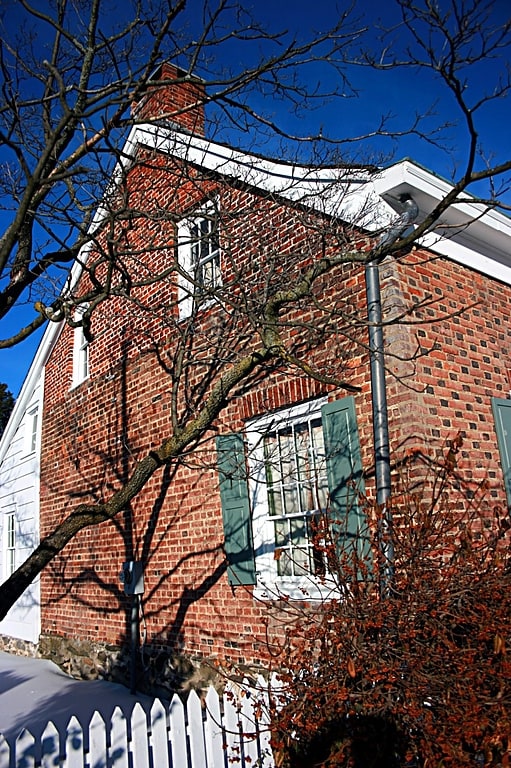
Building in Poughkeepsie, New York. The Glebe House is an 18th-century Georgian brick building in Poughkeepsie, Dutchess County, New York, USA. It is listed in the National Register of Historic Places as a historic place of local significance since 1982.
The name "Glebe House" refers to the glebe, an area of land the proceeds of which supported the parish and its minister. The land associated with Glebe House was about 1 square kilometre (250 acres) in size.
The Glebe House itself was constructed in 1767 as a Georgian red brick building on a rubble stone foundation. It was to serve rectory for the Reverend John Beardsley, who ministered at Christ Church, Poughkeepsie and Trinity Church in Fishkill and his family in 1767. Since Beardsley was a Loyalist, he and his entire household were forced to flee to New York City in December 1777 to seek the protection of the British during the American Revolutionary War.
After 1777, the house and the land passed through many hands. During this time, it housed a public beer garden and later a florist business. In the early 19th century, an addition to the building was made by Peter De Reimer.
In 1929, the house and the remainder of the glebe land (now less than 1 acre) were purchased by members of the Dutchess County Historical Society and the Junior League to protect it from demolition. The house was given to the City of Poughkeepsie to be operated jointly by the Dutchess County Historical Society and the Junior League.
The Dutchess County Historical Society was involved with the house from 1929 to 2016. Now home to Fall Kill Creative Works.[28]
Poughkeepsie Meeting House
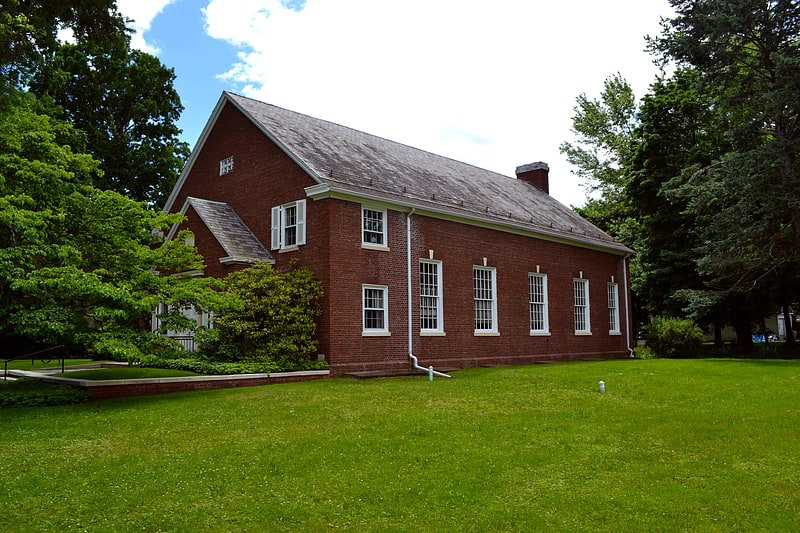
Building. Poughkeepsie Meeting House is a historic Quaker meeting house at 249 Hooker Avenue in Poughkeepsie, New York. It was built in 1927, and is a two-story, rectangular, Colonial Revival style brick building, with a basement. It has a gable roof and projecting entrance pavilion.
It was listed on the National Register of Historic Places in 1989.[29]
Poughkeepsie Underwear Factory
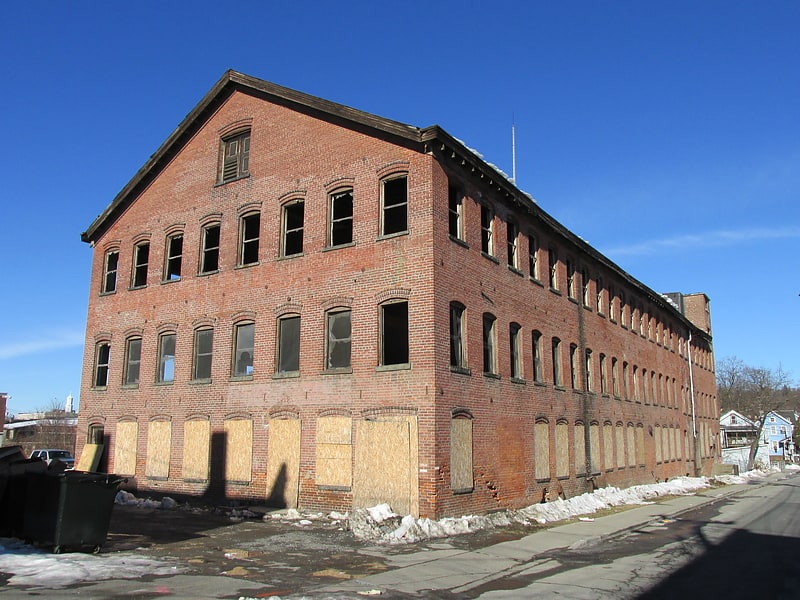
Poughkeepsie Underwear Factory is a historic factory building located at Poughkeepsie, Dutchess County, New York. It was built in 1874 and is a 3+1⁄2-story, eight-bay brick building. It was expanded about 1887.
It was added to the National Register of Historic Places in 1982.[30]
Address: 8 N Cherry St, 12601-3439 Poughkeepsie (Poughkeepsie)
Maple Grove
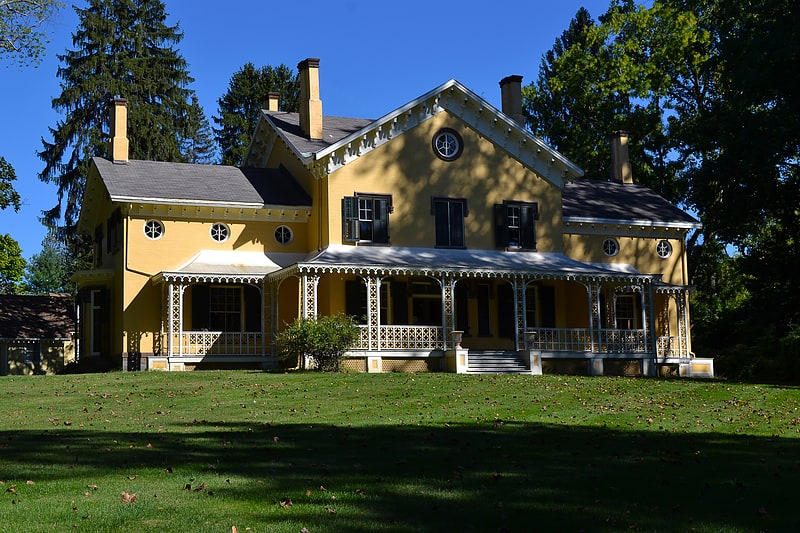
Maple Grove is a historic estate located at Poughkeepsie, Dutchess County, New York. The estate consists of eight contributing buildings: the main house, farmer's cottage, barn, carriage barn, garage, shed, and two cottages. Also on the property is a pair of contributing sandstone gateposts. The main house was built in 1850 in the Italianate style and remodeled in 1891. It is constructed of painted red brick and has a 2+1⁄2-story, three-bay, main block flanked by 2-story, three-bay-wide wings. It has a large, 2-story rear kitchen wing. It features a prominent 1-story open wood porch.
It was added to the National Register of Historic Places in 2001.[31]
Pelton Mill
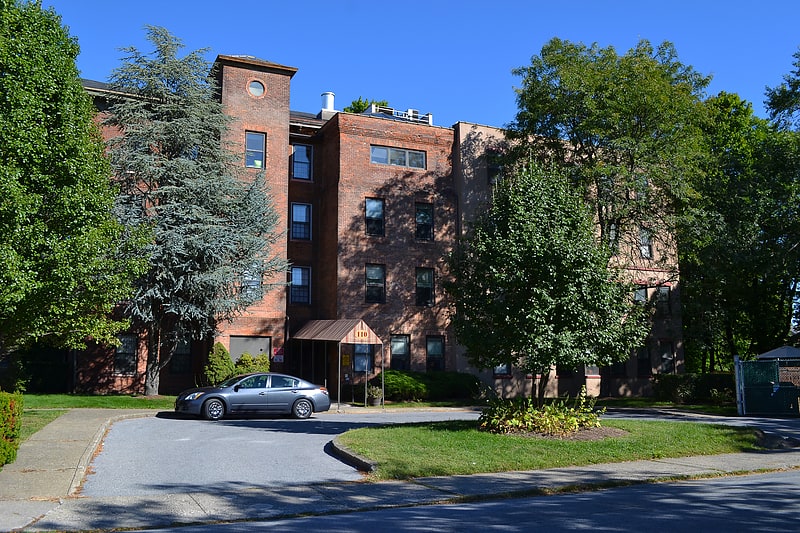
Pelton Mill is a historic carpet mill located at Poughkeepsie, Dutchess County, New York. It was built about 1834 and rebuilt after the fire of 1854. It is a 4+1⁄2-story, three-bay brick building with a gable roof.
It was added to the National Register of Historic Places in 1982.[32]
Smith Metropolitan AME Zion Church
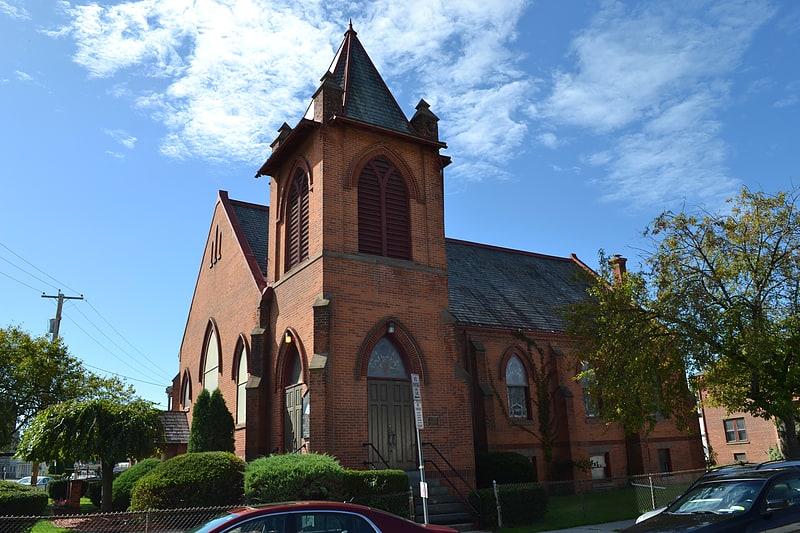
Methodist church in Poughkeepsie, New York. Smith Metropolitan AME Zion Church is a historic African Methodist Episcopal Zion Church located at Smith and Cottage Streets in Poughkeepsie, Dutchess County, New York. It is the oldest predominantly African-American church in Dutchess County, NY. The church was a part of The Underground Railroad led by Civil Rights leader Harriet Tubman. The first black female judge in America, Ms. Jane Bolin, was a member of this church, along with other influential people. The church has experienced phenomenal new growth under the leadership of their Pastor, Reverend Edwrin Sutton. The Church as a ministry began in 1836. The church building was built between 1908 and 1910, with the parsonage added in 1914. The one-story, rectangular Gothic Revival church has an attached two-story bell tower topped by a pyramidal roof and a raised basement. The brick building features pointed arched openings and stained glass windows.
It was added to the National Register of Historic Places in 1991.[33]
Innis Dye Works
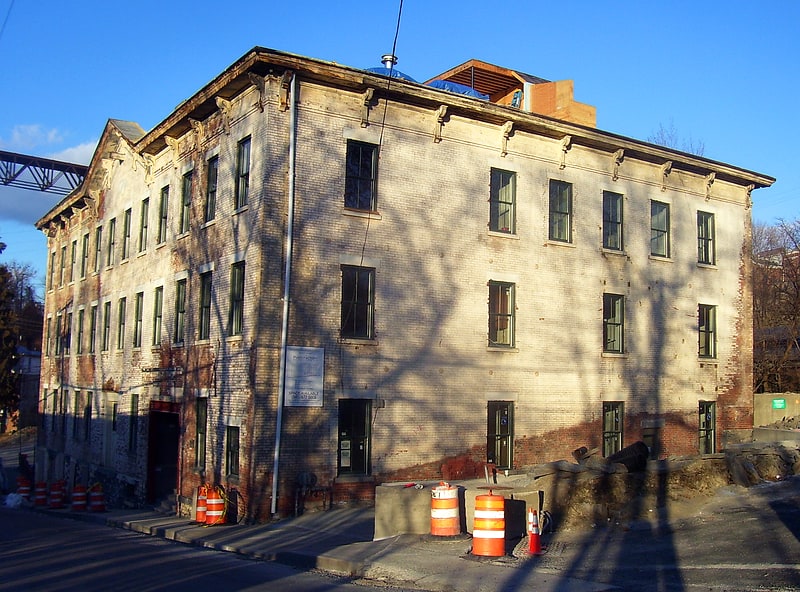
The former Innis Dye Works factory is located along North Water Street in Poughkeepsie, New York, United States, on a triangular lot between the street, Fall Kill and the railroad tracks of the Metro-North Hudson Line, just across from the Mid-Hudson Children's Museum. It has served a variety of industrial functions, and remains in good condition today.
It is a three-story, twelve-bay structure with a raised basement. At the roofline is a projecting cornice and frieze with large carved brackets. A triangular pediment in the center gives the year of its construction, 1880. There is a wooden hoist at the center of the second story and the main entrance is a double door with vertical planking.
The Innis Dye Works company dates to at least the 1830s. The first record of its existence, in 1838, is founder Aaron Innis's transfer of the company to his son George, later a three-time mayor of the city. The building itself was used for pulverizing and storage of materials to be made into dyes. It is shown on an 1887 map of the city.
At the end of the century the building outlived its original purpose when the traditional dye industry gave way to aniline-based mixtures. By 1913 it would be reused as the David H. Schmidt Piano Hammer factory, whose name is still visible on the facade between the second and third stories. It was converted back to dyemaking again by 1934; since then it has been used as a warehouse. It was nominated for listing on the National Register of Historic Places in 1982, consistent with the requirements for listing described in a 1980 study of historic resources in Poughkeepsie, and it received NRHP reference number 82005072, but was not in fact listed due to owner's objection.
It was converted into condominiums in 2008.[34]